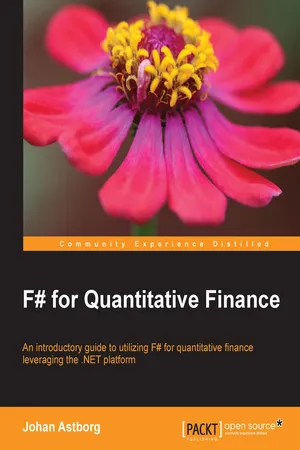![]()
F# for Quantitative Finance
![]()
Table of Contents
F# for Quantitative Finance
Credits
About the Author
About the Reviewers
www.PacktPub.com
Support files, eBooks, discount offers, and more
Why Subscribe?
Free Access for Packt account holders
Preface
What this book covers
What you need for this book
Who this book is for
Conventions
Reader feedback
Customer support
Downloading the example code
Errata
Piracy
Questions
1. Introducing F# Using Visual Studio
Introduction
Getting started with Visual Studio
Creating a new F# project
Creating a new project in Visual Studio
Understanding the program template
Adding an F# script file
Understanding F# Interactive
Language overview
Explaining mutability and immutability
Primitive types
Explaining type inference
Explaining functions
Learning about anonymous functions
Explaining higher-order functions
Currying
Investigating lists
Concatenating lists
Tuples
The pipe operator
Documenting your code
Your first application
The whole program
Understanding the program
Extending the example program
The entire program
The power of prototyping
Functional languages in quantitative finance
Understanding the imperative code and interoperability
Summary
2. Learning More About F#
Structuring your F# program
Looking into modules
Using functions and values in modules
Namespaces
Looking deeper inside data structures
Record types
Discriminated unions
Enumerations
Arrays
Interesting functions in an array module
Lists
Pattern matching and lists
Interesting functions in a list module
Sequences
Interesting functions in the sequence module
Sets
Maps
Interesting functions in the map module
Options
Strings
Interesting functions in the string module
Choosing data structures
Arrays
Lists
Sets
Maps
More on functional programming
Recursive functions
Tail recursion
Pattern matching
Incomplete pattern matching
Using guards
Pattern matching in assignment and input parameters
Active patterns
Introducing generics
Lazy evaluation
Units of measure
Asynchronous and parallel programming
Events
Background workers
Threads
Thread pools
Asynchronous programming
The F# asynchronous workflows
Asynchronous binding
Examples of using an async workflow
Parallel programming using TPL
MailboxProcessor
A brief look at imperative programming
Object-oriented programming
Classes
Objects and members
Methods and properties
Overloaded operators
Using XML documentation
Useful XML tags
Typical XML documentation
Summary
3. Financial Mathematics and Numerical Analysis
Understanding the number representation
Integers
Two's complement
Floating-point numbers
The IEEE 754 floating-point standard
Learning about numerical types in F#
Arithmetic operators
Learning about arithmetic comparisons
Math operators
Conversion functions
Introducing statistics
Aggregate statistics
Calculating the sum of a sequence
Calculating the average of a sequence
Calculating the minimum of a sequence
Calculating the maximum of a sequence
Calculating the variance and standard deviation of a sequence
Calculating variance
Calculating standard deviation
Looking at an example application
Using the Math.NET library
Installing the Math.NET library
Introduction to random number generation
Pseudo-random numbers
Mersenne Twister
Probability distributions
Normal distribution
Statistics
Linear regression
Using the least squares method
Using polynomial regression
Learning about root-finding algorithms
The bisection method
Looking at an example
Finding roots using the Newton–Raphson method
Looking at an example
Finding roots using the secant method
Looking at an example
Summary
4. Getting Started with Data Visualization
Making your first GUI in F#
Composing interfaces
More about agents
The user interface
The main application
Learning about event handling
Displaying data
Extending the form to use a table
Displaying financial data from Yahoo! Finance
Understanding the application code
Extending the application to use Bollinger bands
Using FSharp.Charting
Creating a candlestick chart from stock prices
Creating a bar chart
Summary
5. Learning Option Pricing
Introduction to options
Looking into contract specifications
European options
American options
Exotic options
Learning about Wiener processes
Learning the Black-Scholes formula
Implementing Black-Scholes in F#
Using Black-Scholes together with charts
Introducing the greeks
First-order greeks
Second-order greeks
Implementing the greeks in F#
Delta
Gamma
Vega
Theta
Rho
Investigating the sensitivity of the greeks
Code listing for visualizing the four greeks
The Monte Carlo method
Summary
6. Exploring Volatility
Introduction to volatility
Actual volatility
Implied volatility
Exploring volatility in F#
The complete application
Learning about implied volatility
Solving for implied volatility
Delta hedging using Black-Scholes
Exploring the volatility smile
Summary
7. Getting Started with Order Types and Market Data
Introducing orders
Order types
Market orders
Limit orders
Conditional and stop-orders
Order properties
Understanding order execution
Introducing market data
Implementing simple pretrade risk analysis
Validating orders
Introducing FIX and QuickFIX/N
Using FIX 4.2
Configuring QuickFIX to use the simulator
Summary
8. Setting Up the Tradi...
